| |
LOOPS & GAPS: Video as Entrance into the Unknown1
The starting Point
I?
In his 2004 film, I? of 4.17 minutes, Shahram Entekhabi (Iran 1957) revisits for contemporary culture the concept of Samuel Becketts’only film, called FILM, starring Buster Keaton (1965). In the typical and, by 1965 historical fashion of early cinema that had no dialogue, lots of body movement, and visual explorations of the shock encounter with the city that characterized modernity, Keaton, 40 years beyond his greatest successes jumps and scuttles around in New York City, never showing his face to passers-by or public. In the final shot, and in what might be an ironic concession to the viewer hungry for realistic solutions, it turns out that face is hideously distorted.
The primary element of Beckett’s concept is the unlikely combination of going around in the public space of the city while never revealing the face. Then, in his bare apartment, he cannot avoid the eye of the other. He must destroy all images, as well as eliminate all eyes, to be able, finally, to look into the camera. This is, in the end, a narrative film, even if no word is spoken.
Entekhabi takes the conceptual nature of FILM up but omits such a reassuring ending – reassuring because it projects the refusal of the face-to-face on the figure who hides. Entekhabi’s lone figure is never seen because the environment doesn’t care to see him. For today, it is of crucial importance to reflect on the relationship between the individual subject whose life the constitution demands we respect, and the larger communities whose members the Western world denies that individuality. For, as I? in its intertextual relationship to FILM seeks to explore, it is not productive to remain obsessed with the individual face as long as a true face-to-face cannot occur. As it happens, the film doesn’t manage to be narrative, either. It just describes ten episodes of an ordinary day, in no particular order and without any event out of routine.
The mechanics of a conceptual exploration, abolishing the heroizing individualism that subtends Hollywood stardom along with elite notions of artistic genius, offer an opportunity to research identity without sentimentalizing that concept, reclaiming it from abuse in identity politics and its backlash. Instead, identity is connected here to what most profoundly characterizes it – the images, including the faces of others, which surround us. In I?, ten very short sequences position the Migrant in different urban spaces that hint at his everyday life, from a shave in his own home to the market, the coffee house, and returning to the apartment building he lives in. A full day, a full life, and no face-to-face. The only image that can follow this day is the reiterated first one, the shave in front of a mirror in which we cannot look. Unlike narrative, the film, essentially to be displayed on a loop, has neither beginning nor ending.
I? became the starting point of a series of short films Shahram and I made together, in which the inscription of historical (dis-)continuity crossed with geographical failed encounters is shaped further. In a variety of ways we tried to “boycott” narrative at least in its traditional guise, in order to avoid some of the power structures that inhere in that mode. The first narrative aspect we tried to avoid was the narrator, or voice. My critique of voice in the article makes clear why: first, to avoid the authority of a speaker and replace it with a performance that puts the burden of representation not in one basket but in that of the performer and the people he interacts with, as well as the camera whose activity is made visible by the mode of editing.
Second, we sought to avoid the illusion of an origin of the story, of a “past tense,” so as to make the event one in the present. A third reason to avoid classical narrative has more to do with plot, or diegesis, than with voice per se. It is the coherence such a voice presupposes and promotes, and from which a sequence of events ordered and focalized would derive its privileged status as narrative, with all the realistic illusions and naturalized logic this status brings. Hence, we refused the sequence of events, replacing this by single, disconnected happenings. In these films, the everyday life of the migrant is further stylized and reduced to single acts: traveling, looking for work, intervening in public space, offering cake on his birthday, standing in the street with a bunch of flowers looking for someone to give them to, running away from suspicious urbanites who finally see him, and think he’s up to no good. This conclusion is the equivalent of the loop that starts at the beginning, endlessly repeating entrance and exit, while conflating that social reality with the collapse of the look: looking as being-looked-at.
In an exploration of the media that have shaped our visual consciousness, the works show that the temporal looping that characterizes video installation is on a par with a multiple “looping” that is visual, social, and “mediatic.” In addition to the circularity of looping that precludes the suspense-raising beginning and the satisfying ending of narrative, the films are marked by gaps. They show a constant interruption, sometimes a failure of the action, as in Alcazar, sometimes a visual interruption of movement, as another way of creating never-ending stories, as in Road Movie.
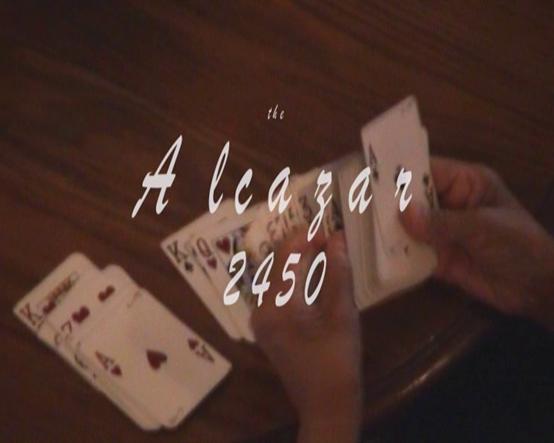
The films reflect (on) the medium in which they are made, sometimes to the point of interrupting the medium itself, as in Rockefeller Boulevard. At the same time, they] The films reflect on the hierarchies among media, in particular, the prime position of painting in the Western artistic tradition since the Renaissance, on the one hand, as a counterpoint to the lure images constitute for prospective migrants, attracted by blondes and cars, both equally flashy; and, on the other hand, narrative, the structure with beginning and end that informs us about events, forming sequences and frequently involving a crisis, told by a narrator or “voice,” versus the endless series of unspectacular, “trashy” narratives that “just happen” as a way of shaping the everyday life in a cultural setting.
Road movie
Depending on when one enters the gallery space, the film looks like a still photograph, evoking a traditional landscape painting, or like a film. The one-shot film Road Movie is 17 minutes long. On a four-lane highway, dangerously close to the cars, on the edge of a green median stretch of hollow road, a man walks. The man in the somewhat shabby, slightly out-of-style but very proper suit and black shoes just walks away, his back turned to us. He carries two old cardboard suitcases. He walks fast and disappears into the distance, into nothingness. He never looks up. Cars keep rushing by. Then for at least eight minutes nothing happens but more cars.
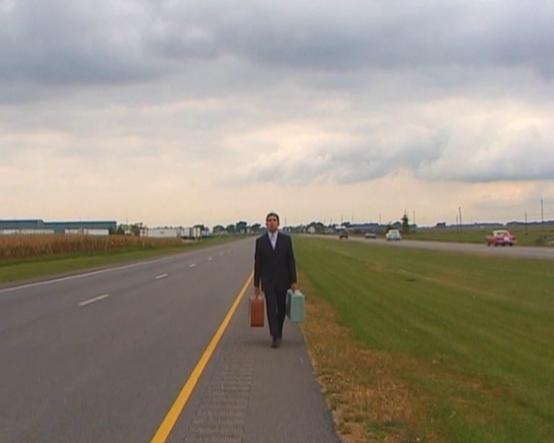
Just when the viewer might get a bit annoyed by the narrative silence, something happens again. From very small to recognizable, the man comes back, as a relief of the tension emptiness creates. But to process this as a narrative one begins to ask questions that explain the two otherwise disconnected events of his departure and his return. Was he sent back at the other end, refused entry or chased away by angry Americans-only types, or did he return because America has nothing to offer? Or did he return in belated acknowledgement of the viewer? At the end, he comes close enough to looks at us, but he doesn’t ever look us in the eyes, because he is too busy walking on. That’s all.
For the viewer something else happens. First, when you see him walk away, it is simply an event that doesn’t concern you. He seems a bit out of place under the ominous clouds, but since we only see him from the back, we can’t quite tell. Formally, it is a narrative “in the third person,” about someone else. You look on, the way you ordinarily look, with indifference. An unreflective look, taking in only what interests us, remaining on the surface of everything else: this is the look the first half of the film solicits. When he has disappeared and the image remains empty of his presence, the memory of his passing by seems like a little piece of lint on a black shoulder, swatted away in an unconscious gesture of propriety. This man wanted to come and stay among “us” – fine. We don’t give it a thought. The empty road is the image of normality. His disappearance depletes whatever narrative expectations we might have had, so that the film becomes a photograph again.
But that image, when nothing happens, becomes boring and, by means of that boredom, it does begin to intrigue us. What’s the point of this emptiness? Why would this be what we want: because we know it so well, because it is what we find normal, although the lack of meaning begins to glare at us as soon as we start to think? This is the turning point, long before he turns around and walks back. The turning point of the act of viewing is the moment boredom becomes a trigger of asking ourselves questions about the point of our existence, not that of the anonymous walker.
But boredom is also triggered by the conceptual and sensory gap between film and painting. One would not be bored looking at a landscape painting, however long one feels like it. Knowing this is a film, instead, mobilizes the spectacle-induced expectation of action. This is how boredom is anti-narrative; it is what makes narrative intolerable. When we get bored, we shut ourselves off, close the book, or leave the film. Between the departure of the man and his return, the expected action remains like a glaring gap. For, strictly nothing happens. That nothing kills narrative.
In the middle of this mood change, in the far distance where the vanishing point has swallowed him, a tiny figure appears. It’s the man, reappearing. Strangely, now the viewer looks actively forward to his approach. He is facing us and we are getting ready for an encounter. The previous emptiness that had triggered a simmering of melancholy is going to be relieved. Even the sky has cleared up a little bit. He comes closer and we look at the rhythm of his equally fast, although slightly more tired steps. The visual discourse has changed profoundly. From a narrative in the third person, we are now set up as the “first person,” having an active experience, addressing with our eyes the other who is the “”second person,” and as a result, our affective relationship to the figure and his return may change.
When, finally, he comes to us, however, he just walks out of the image. Not for a moment can we look him in the eyes, can the encounter that we desire so, and that would turn this non-story into a narrative, take place. Is it that, after having been rejected once too often, he cannot be bothered with our needs to feel good about ourselves? He turns the table on us, responding to our previous indifference with his own. But these speculations stem from a narrative desire to fabricate a story. His pale face lets us try many possible readings: exhaustion, perhaps anger, but really, nothing is readable in it. No imploring, no begging for mercy, no demand for sympathy and contact. We did not see him, now he does not see us. It’s too late. Too late for contact, to late for a story.
The man’s disappearance into the vanishing point is a literalized metaphor of the image’s deceptive superficiality, disguised as depth. When after the man’s disappearance, nothing else happens but cars rushing by, the frustration engages video on its own terms. Only when we have shed the habit of seeking to reach beyond visibility will the visibility that video offers strike home in full force. The boredom of the film’s length is in turn a metaphor for the temporality of the loop.
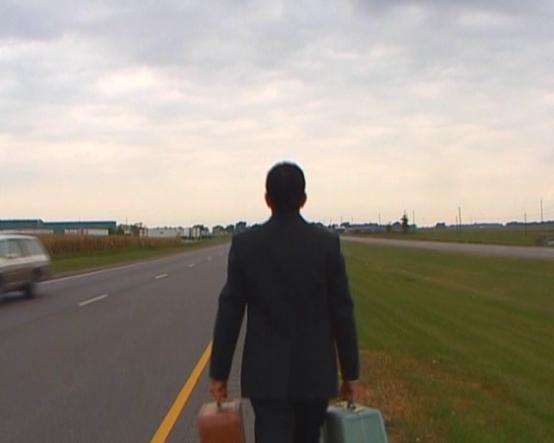
In the other films of the series GAPS, we see what might have happened during the primary gap that constitutes this film’s anti-narrative void: that time during which he was, so to speak, inside the vanishing point. These tiny events, in turn, also constitute interruptions, gaps, disappointments.
Caution
Caution responds to the tradition of performance art. This movement that started in the late 1960s sought to denounce the deceptions of art, including the theater and its narrative realism, and the subordination of viewers condemned to passivity. Performance art resisted narrative. Here, the man reappears on the prestigious oval lawn in front of the library, where students walk by to go to classes. A normal day on an American campus. Nothing seems likely to happen, and for a few minutes, that is just what you see, from the distant height of a rooftop, as well as from the frontal and side positions on the ground. The overt and fast editing undercuts the smooth narration one might expect. The tiny figure walking the middle of the path opposite the high viewing point, strikes as slightly out of place: the gap is put in place, visually. It is also put in place in the performance, as he walks faster than others, as if he had a purpose.

He begins to unroll red-and-white European caution tape, routinely used to block off areas that represent a danger for the public. He knots the end of that tape to a tree. With fierce determination – or is it resigned repetition? – he screens off an area. Repetition, here constituting a dense sculptural wall of bright colors, establishes the hallmark of the series as video installation. Repetition also counters narrativity, where retroversion, instead, helps the story along. Then, he begins a somewhat longer walk over the lawn to the other side of the oval. He attached the tape to a tree there, then returns.
Color, sculpture, and performance vie for attention as the kick-off media, measured against video’s power to make surface stick on the retina. Some of the images ask how it is that space can get overruled by intervention. When the people behind the tape lose their visibility, or their faces, for example, one can wonder how abstract art – here, blocks of bright red and clear white – takes over figuration as if it had always been lodged at the latter’s heart. Or, whether it is the walking man who is the sculpture, or the tape waving in the wind. One wonders, too, about the blandness of the public space before, and its new look after the intervention. And of course, the close-ups of the action are fundamentally different from the long shots, just as the actions differ. All these musings concern visual, not narrative aspects.
But other details are not so clear-cut void of narrativity. The walk across the lawn is bolder, and longer, and more incomprehensible than the earlier, shorter itinerary. His walk is steady, remains faster than “normal,” and his face remains unreadable. At one point, he is himself inside the space he is creating, turning sculpture inside out. But being inside is only for the performer; everyone else is kept out. This inside-outside dynamic creates a new gap, between expectation and the small change effected upon it by this stranger. Instead of protecting the people from accidents, the caution tape pushes them out of the space they consider legitimately theirs. What seemed without story becomes a potential story of war.
Ostensibly playing a role, he marks a gap as the discrepancy between the man and the people walking around on the campus is visible in the traces of migrant existence. The sense of belatedness translates into his somewhat sped-up pace, his whitened face expresses no communication with others, and his determination to succeed in whatever it is he is doing, seeps out of the eyes-hand coordination – also characteristic of what artists do.
When the act is done, he turns around and walks away, just as briskly as his arrival stride, trailing the last end of the tape behind him. Mid-path he tosses the remaining spool into the bushes, as if symbolically tossing away narrative potential, and he is gone. The image from the roof shows the difference he leaves behind. He has come and gone, but the space is definitively altered.
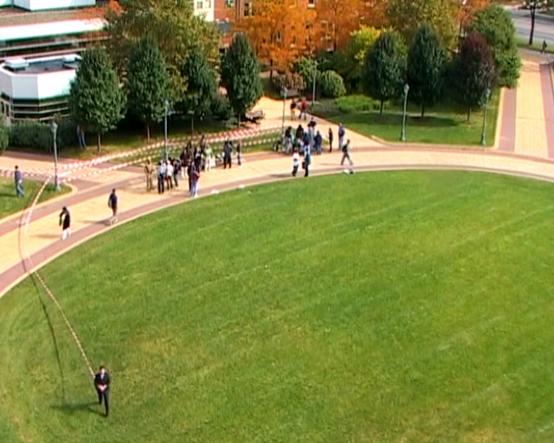
Is this a narrative? Yes and no, or rather, at first no, then yes, after all. Avoiding a narratorial voice in video is nothing to write home about. But to avoid what “voice” stands for is easier said than done. Instead of a voice, there is the organizing editorial hand, but in spite of the attempt to show its hand by fast cutting, we cannot take that hand for a voice. Rather, the editing is subjected to two competing “voices”: the performer who centers the images, and the relentless dictate of sequence. The minuscule acts that constitute the larger intervention are, as narratology has it, “logically and chronologically” ordered. The onlookers or indifferent bystanders and passersby moreover, create what can be called a “sense of narrative.” Any moment, one expects one of them to respond, and act in relation to the performance, thus breaking the invisible wall between the performer and the public and turning the performance into a narrative. Does it happen, hence, does an embryonic narrative occur? Yes, almost, when two people cross at the exact place where the tape cuts the path in two. But then, no, when they each simply lift the tape and walk underneath it, separating again. Not even an encounter takes place. Narrative is again aborted.
Rockefeller Boulevard
Yet another act happens in the gap when the figure had disappeared in Road movie, but do not expect it to be related. The wind blows fiercely; the legs of his pants flip-flop, showing the thinness of the fabric. He must be cold, and the hot climate of his home emerges by contrast. Just as the media of photography and video, here, are set off against each other. If you need a story, it would be this account of what happened during the time he was gone, in Road Movie, in the vanishing point. With the two suitcases that mark his recent arrival, he explores different sites on a large, impenetrable space. Urban, but without people; desolate, without nature. The industrial area of a city that is long past its economic flourish. He walks past huge oil containers, that ironic icon of the Mid-West’s appropriation of the middle-East’s natural riches. Between him and the containers stands an insurmountable fence. Then, looking around, sitting at a picnic table, peeping into broken windows, walking along an unreadable low building, he seems lost. In the distance, a chimney still vomits clouds, unreachably far-away symptoms of possibility; a reminder of what he came to search.
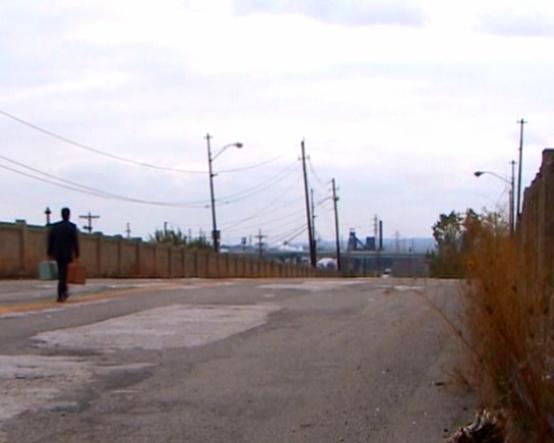
But, embodying retroversion, he is irremediably late. Industry is over. The buildings to which he came, on which he had set his hopes for a better life, are ruins of history. By the time he has understood that the only way to survive was to follow the oil from his country to its destination, the oil had burned up. Modern times have become an object of nostalgia, and the Migrant is no longer wanted. In the end, we imagine, he returns to the invisible point from whence he came, on this side of the camera.
But this story is as out of joint as everything else in this series. Here, this out-of-jointness is given shape by video’s struggle with the gap as such. The video is constantly interrupted. The bits of moving image are powerless against the almost violent way the gap takes over. Since the migrant never reaches any destination, the obsoleteness of the industrial building loses its relevance. For historical time always holds the promise of a return of the swing, a utopian possibility that things will get better. The halting rhythm of this video holds such false promises at arm’s length.
What happens in the gaps – the primary one, within Road Movie, the ones within Rockefeller Boulevard, and the ones between the films, is further de-narrativized by the incongruity of moods. Alcazar is a deeply melancholic film, Caution a mildly comical one. It fits the mood of Rockefeller Boulevardthat the audio-visual stagnation is set in grey tones, only sparsely interrupted by sap green and ochre, with a grey-blue sky. These colours disappear along with the readable image when the interruptions occur. The colours of painting cannot hold up against the reproducible images that have taken over the public domain. In this sense, this video is also a meditation on the monopoly of electronic media, the accounts to be settled with the arts of the past, and the new art that can emerge when all else fails. This, too, is a commentary on the culture of migrancy.
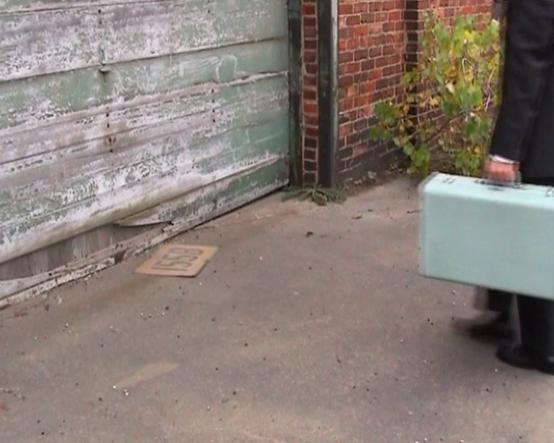
What I submit for discussion here, in this context, is what I see as the wavering between narrative temptation and the ultimate failure of narrative, both phenomena leading to the question of performativity. If on the one hand, the narratorial voice in its cinematic form of camera and editing, is countered, if its power is taken over by performer and unreflecting bystanders, and on the other, the coherence of the series of events in sequences with some logical and chronological solidity is destroyed by gaps of all kinds, do we therefore have to say that narrative is no longer at issue in these films?
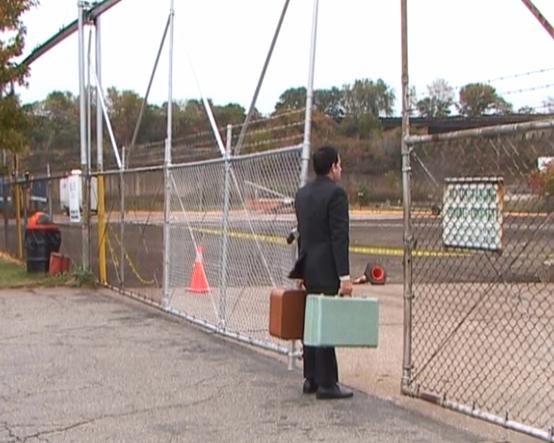
Personally, I don’t think so. I am convinced that the impulse, or desire, for narrative, is so strong that precisely those gaps that destroy the potential story also generate the possibility of story. Without falling back of phenomenological accounts of gaps, such as Wolfgang Iser’s “leerstelle,” I would like to hear your view of what those gaps do there, in the larger part of Road Movie, between the films, or acts, and in Rockefeller Boulevard. Without being characters or events, the gaps are something, do something. And when beings and doings get together, classical narratology holds that story begins.
Notes
|

1 The current text was prepared on the basis of a lecture, delivered in Amsterdam: ASCA Soirées “Stories that Just Happen: Performative Narratology”, 4-04-2005.